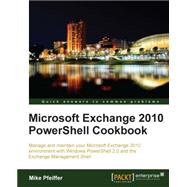Microsoft Exchange 2010 Powershell Cookbook: Manage and Maintain Your Microsoft Exchange 2010 Environment With Windows Powershell 2.0 and the Exchange Management Shell
, by Pfeiffer, Mike- ISBN: 9781849682466 | 1849682461
- Cover: Paperback
- Copyright: 7/30/2011
Microsoft Exchange Server 2010 is a complex messaging system with many features. In order to ease the burden on IT administrations, Exchange 2010 supports a management architecture built on Windows PowerShell 2.0, called the Exchange Management Shell. Using this management architecture, administrators can gain more efficiency then ever by automating routing tasks through PowerShell scripts and one-liners that save time and eliminate errors.This focused practical cookbook will show you how to manage and maintain your Microsoft Exchange Server 2010 environment with Windows PowerShell 2.0 and the Exchange Management Shell. It provides recipes for solving common scripting tasks and problems based on real-world scenarios.The book is full of practical, immediately usable task-based recipes that will enable you to manage and maintain your Microsoft Exchange 2010 environment with Windows PowerShell 2.0 and the Exchange Management Shell. It starts with key PowerShell concepts that lay the foundation for the scripting examples used throughout the book. You will then move on to common Exchange Management Shell tasks, enabling you to get connected to servers, run reports, and automate tasks. The book then takes you on a deep dive into topics such as Managing Recipients, Managing Mailboxes, Distribution Groups and Address Lists, Mailbox and Public Folder Databases, Client Access Servers, Transport and High Availability, amongst others.






